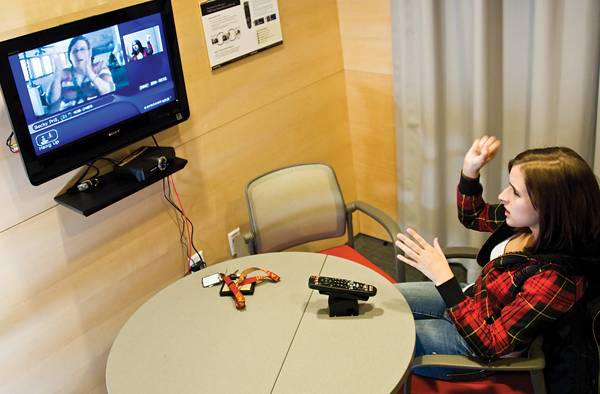Phone allows long-distance signing

Maggie Luttrell, senior in history, and her mother, Becky Prill, speak in sign language on Iowa State’s first videophone. Both of Luttrell’s parents are deaf. Photo: Jon Lemons/Iowa State Daily
March 2, 2009
As she sits in front of a plasma screen television, she pushes 10 numbers on a remote control aimed at what looks like a standard VCR.
After a few seconds of delay, an image of a woman appears on the screen and a smile comes across the girl’s face. “Hi, how are you? Where are the cats?” she signs in Standard American Sign Language.
Maggie Luttrell, whose parents are both deaf, was able to speak to them in another form, besides text messaging or e-mail, for the first time in four years with the help of disability resources and the Multicultural Center.
Iowa State installed its first Sorenson Videophone last week, a technology that allows video communication among deaf, hard-of-hearing and hearing individuals.
The videophone was installed in the Multicultural Center on Feb. 20, and Luttrell, senior in history, was there at 10 a.m. Friday, when the center opened, to speak to her dad.
”It was so awesome, after four years, I could just be like ‘Hey dad, how’s it going?’” she said. “There’s only so much you can say through text message, sometimes it’s easier just to say something or sign something.”
Steven Moats, director for Student Disability Resources, said obtaining the university’s first videophone was a lengthy process that included several steps. Student Disability Resources investigated the product then contacted the Memorial Union and other partners to verify logistical solutions in order to house the phone. Finally they partnered with IT services to get the equipment hooked up through a dataline. After that, the dean of students office granted approval to move forward with the installation.
Moats said a sizable donation was made by an ISU alumnus, Keith Sargent, to purchase the monitor. Multicultural Student Affairs supplies a monthly payment in order to maintain a wireless connection to the dataline.
The university is not obligated to provide a service such as this. However, Moats said, with the growing number of students who are deaf or hard of hearing, or who have parents and siblings who speak in sign language, the technology had become more feasible for the university to purchase.
Moats said there are approximately 25 students registered through the disability resources office who are deaf or hard of hearing.
“It’s an opportunity to help all people be able to communicate to people who are important to them, and the technology allows that to happen,” he said.
In Luttrell’s experience, not being able to talk to her parents during her college career has been a difficult journey.
”It’s very, like, isolating. When most college students have a bad day they’re like: ‘Mom, my day sucked,’ and they’re very nurturing, like parents always are,” she said. “Sometimes you just want to talk to your parents, and it’s very isolating when you don’t have that.”
Moats said housing the videophone in the Multicultural Center demonstrates the university’s commitment to diversity.
“It’s a way to demonstrate diversity on campus and to be inclusive of all people,” he said.
The videophone is available for student use when the Multicultural Center is open. The second party is required to have a Sorenson Videophone. Videophones are available free of charge for deaf or hard-of-hearing persons.
Multicultural Center hours:
10 a.m. to 11 p.m. Monday through Thursday
10 a.m. to 5 p.m. Friday
Noon to 5 p.m. Saturday
5 to 11 p.m. Sunday
















